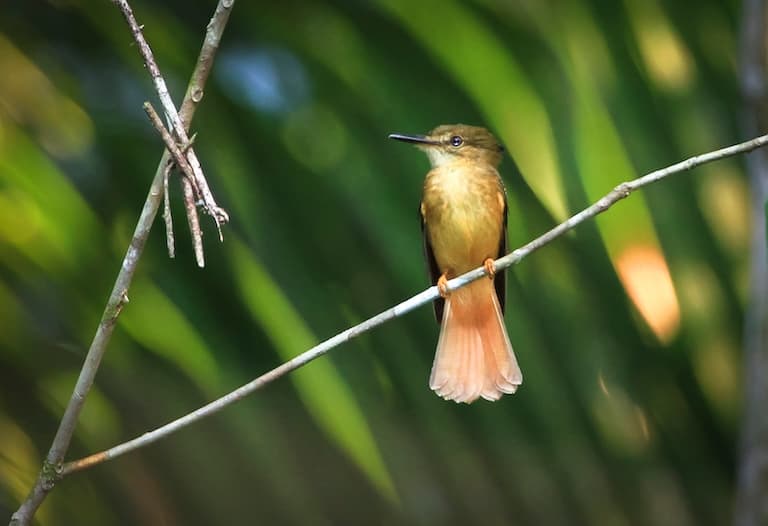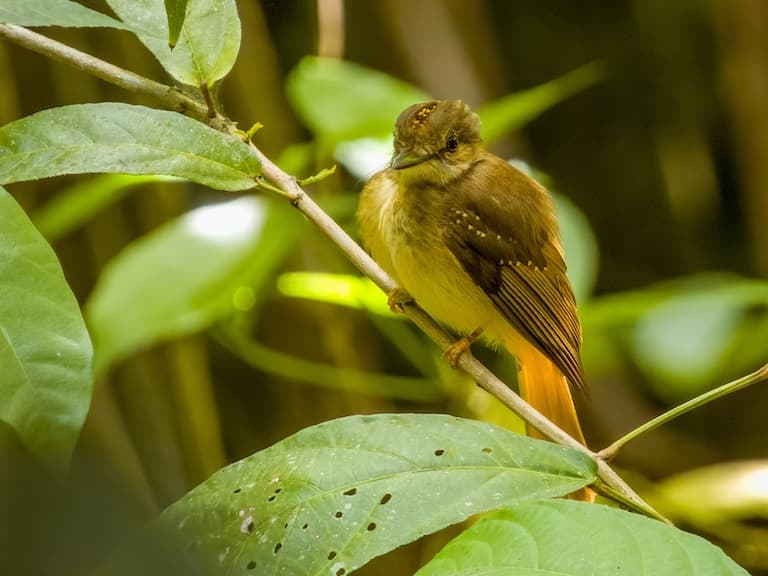Tropical Royal Flycatcher Profile
In 1955 a researcher with the inconspicuous name of Sibley triggered a cascade of events that could only occur in the crazy and exciting world of ornithology.
Sibley had been reaching into holes to grab tits to record how they wiggle when molested. Sibley’s so-called “snake display” was subsequently described in another species by Wetmore, Dick and Bangs, who were independently studying the erections on a different species: The Tropical Royal Flycatcher.
The whole shebang was summarised in 1990 by Gary R Graves: the only man dead serious enough to write it out in one go.

Tropical Royal Flycatcher Facts Overview
| Habitat: | Humid lowlands |
| Location: | From southern Mexico to northern and central South America |
| Lifespan: | Unknown |
| Size: | 12.5 to 18 cm (4.9 to 7.1 in) long |
| Weight: | Up to 21 g (0.74 oz) |
| Colour: | Dark brown upperparts, golden brown below, reddish tail |
| Diet: | Insects |
| Predators: | Snakes, larger birds |
| Top Speed: | Unknown |
| No. of Species: | 1 (or 2, 4, or 5, depending on who you ask) |
| Conservation Status: | Least Concern |
The erections on these birds have been a matter of curiosity for ornithologists for a long time. It’s clear they’re used in defensive displays, as seen in clips of overly-handsy birders tormenting them, but they are also thought to be important contributors to male-female relations; the extent to which is uncertain.
These are quite bland birds with a stunning secret that comes out only when cornered or horny, and while taxonomists can’t yet agree on what they are, their rituals appear to be serving them well, at least for now.
Interesting Tropical Royal Flycatcher Facts
1. They’re New-World Flycatchers
Flycatchers come in two general forms. There are the Old-World flycatchers which include the iconic robin (redbreast) and a bunch of really nice blue ones for some reason, and then there are the New-World flycatchers that are totally different in terms of evolutionary lineage and physical appearance but share the dietary preferences that lend the pair their name.
Both are from the Passerine, or songbird, order, but other than that, they are not closely related. The New World flycatchers, as the name suggests, are from the Americas, and are perhaps better known by their nickname the tyrant flycatchers.
This name stems from an 18th-century English Naturalist called Mark Catesby, who witnessed a single species of flycatcher doing the bare minimum of standing up for itself and in classic colonial British had to shut that nonsense down posthaste.
He branded it the Tyrant, and not long after that, a member of the relatively demure Swedish Empire slapped it on the entire family.
Carl Linnaeus essentially cancelled an entire line of songbirds for fear of an uprising. This is the history nobody is talking about.
The tropical royal flycatcher has shed this reputation to some degree but is now lumped with the ranking of a different type of unelected sponger.

2. There might be a lot of subspecies
Depending on whom you ask, this is one bird species, Onychorhynchus coronatus, with five recognized subspecies.
The subspecies are generally separated by region, with O. c. castelnaui inhabiting areas east of the Andes, O. c. coronatus, occupying Venesuela, O. c. mexicanus found mostly in Mexico and Panama, O. c. fraterculus being from Colombia, and O. c. occidentalis taking its spot in western Ecuador.
All of these inhabit relatively lowland regions, below 1,400 metres, and they prefer the midstory of humid forest, somewhere between the upper canopy and the ground.
But some authorities have them listed as more than one species, and the topic is still up for debate.
The most recent change suggests just one, though, so that’s what we’re going with for now.
And despite being relatively bland for a flycatcher, this species is well studied on account of its erectile crest.
3. They have crests!
The tropical royal flycatcher is the Ned Flanders of the bird world. Relatively dull and average looking at first glance, but when it rips off its shirt it can surprise you with what it’s packing.
The name for this bird comes from their stunning erections, presented on the head as a glorious crown, and shown willy-nilly to anyone who grabs it by the feet.
This response to being caught has commonly been attributed to a defence mechanism but it seems like there’s more to it than that. 1
4. Males and females have crests
Since Sibley’s tit-grabbing adventures, there’s plenty of literature about crested birds from these parts.
And since Wetmore, Dick and Bangs’ exciting escapades into the South American jungle There’s a strong comparison between Sibley’s tits and these regal passerines, at least in the way they wave their heads when caught.
Usually, especially in birds, it’s the male’s erection that is the most impressive, so the fact that both male and female royal flycatchers have them suggests there’s more to it than just sex. And the so-called snake display seen in other birds corroborates this.
And it is definitely true that when caught, these birds do a distinctive head wiggle with their mouths open and their crests at full attention, but the fact that the male and female crests are different colours in this species suggests there’s more to it still. 2 3
5. They have a courtship duet
The crest display is clearly a show of force for both male and female birds, but it is also thought to be an act of love.
In much of the animal kingdom, there’s a lot of overlap in these behaviours, as they suggest good breeding stock, so perhaps this is true for the birds. When courting, the male goes first, displaying his erection to his potential mate.
If she’s interested, she’ll whip hers out in response and the pair will hold them high, appreciating one another while fanning the crests without moving.
A few positive flutters are all it takes for the male to take the hint and approach and copulation is over in five seconds, after which both birds go their separate ways. But the male returns for more validation, hovering in front of the perched female and displaying again.
She returns the favour, showing that the displays are useful at multiple stages of reproduction.

6. They’re probably doing ok
Believe it or not, taxonomists don’t always agree on everything, and so you have sometimes to choose between different authorities when assessing a species’ place in the world.
This is as boring as it sounds for the majority of simple folk, like the humble animal bloggers, who like their coffee black, their bread toasted, and their birds uncomplicated.
But it gets worse when two authorities you trust disagree with one another, like the IUCN using the taxonomy of the Handbook of the Birds of the World to assess the species.
This means there are three IUCN listings for the bird, based on three of the five subspecies, adding a whole dimension of disappointment to the process of assessing how they’re doing. But the good news is, they seem to be ok.
The worst it gets is a level of Near Threatened which is something to keep an eye on, but the most widespread and largest groups are of Least Concern.
While it’s just too easy to mock taxonomy as a meaningless indulgence in weapons-grade pedantry, it’s a really critical component to our understanding of the communities we live in, and while it doesn’t impact most of us directly, it is the groundwork for the research that many zoologists rely on for funding.
And it is this very funding that pays for their nephew’s third yacht, so while we may laugh, it’s from a position of respect for the fundamentals of the science we treasure.
But for those who like to contribute to weapons-grade pedantry, the South American Classification Committee is now accepting submissions for your scientifically backed reasons why a bird is actually five birds or vice versa.
While these tireless nerds work to better the world, the rest of us will continue to lean back, rest our beers on our overhanging bellies and argue over which bird has the biggest erection.
Tropical Royal Flycatcher Fact-File Summary
Scientific Classification
| Kingdom: | Animalia |
| Phylum: | Chordata |
| Class: | Aves |
| Order: | Passeriformes |
| Family: | Tityridae |
| Genus: | Onychorhynchus |
| Species: | coronatus |
Fact Sources & References
- vitekjc (2017), “Royal Flycatcher”, YouTube.
- Gary R. Graves (1990), “Function of Crest Displays in Royal Flycatchers (Onychorhynchus)”, JSTOR.
- Leonardo Chaves (2006), “CREST DISPLAY AND COPULATION IN THE ROYAL FLYCATCHER (ONYCHORHYNCHUS CORONATUS)”, The Neotropical Ornithological Society.
